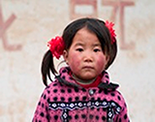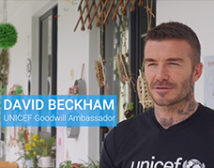The Design for UNICEF class at Tsinghua University for the 2015/16 academic year successfully ended in January. The class is an interdisciplinary design programme in which graduate students from a variety of academic backgrounds, such as visual communications, industrial design and business, work together to examine challenges that UNICEF faces. Under the guidance of the lead professor and UNICEF mentors, students conduct research and propose prototype solutions.
This was not the first time that Tsinghua University and UNICEF collaborated in a design and youth engagement approach. A Design for UNICEF workshop was first led by Professor Yingqing Xu, Chair of Information Art and Design at Tsinghua's Academy, together with Christopher Fabian, co-lead of UNICEF's Innovation Unit, in May 2015. The Design for UNICEF class in the 2015/16 fall semester was an advanced version of the workshop.
To expose students to actual challenges UNICEF is tackling in its field operations, UNICEF China staff members presented the class with three use cases from its current portfolio of health, education and social policy activities. The students were asked to conduct focus group discussions, surveys and other research and present mid-term reports based on the findings and their analysis. These reports were reviewed by UNICEF mentors, who provided feedback to the preliminary research, and helped guide the subsequent research. At the end of the semester, three teams of students presented their findings and solutions to the UNICEF China Office.
 ©UNICEF/China ©UNICEF/China
After the first Design for UNICEF class in China, students and UNICEF staff took a group photo. |
Rana Flowers, UNICEF Representative to China, listened to the presentations, thanked the students for their hard work and encouraged them to continue to closely follow issues around children's rights and sustainable development as they advance their studies.
The Tsinghua University students presented the following three project solutions to UNICEF China.
1. An adapted RapidPro for the China context, to collect data in real time
UNICEF completed a multiple overlapping deprivation analysis (MODA) in Hubei Province as a pilot project. The data gathered in that process, however, was not available in time to inform programme design. This experience underscored the need to collect and analyse data on children in poverty in a timely manner, based on indicators that are defined by individual communities. This challenge is certainly not unique to China, and UNICEF globally has searched for solutions. Among what they have found thus far is RapidPro.
RapidPro is a free and open-source platform for development organizations and practitioners to perform real-time data collection and conduct two-way communication with end users. The platform and its suite of applications have been deployed in more than a dozen countries. The students studies the specifics of rural China, and realized that it required a different interface with a more complex layer of questions and answers. They created a prototype interface that included user-friendly data management, dissemination of educational materials and an online forum for social workers.

A screenshot of part of the user interface design by students. |
2. Social emotional learning for children left behind by migrant parents
The Tsinghua University students wanted to help migrant parents and caretaker guardians of left-behind children understand the importance of social emotional learning and what they can do. The students proposed the use of mobile devices and social networks to reach, train and support migrant parents.
Through questionnaires and interviews, the students identified communication patterns and preferences of parents, teachers and children. Connecting the UNICEF social emotional learning initiative to the current campus pass system was one of the recommendations that was considered particularly practical and innovative by UNICEF staff members.
3. Extending health services to rural communities

A screenshot of one of the storyboards created by the students (a storyboard is a visual representation of a situation, in which the proposed solutions would work).
|
Students identified reluctance to seek hospital care, high economic costs to access health care services and lack of access to health information as the main barriers for rural families to obtain essential health services. They took on the challenge of providing ‘light diagnostic' services, collecting family health data and disseminating health information by creating a system that rural families can access through their mobile phone or a website.
The students' presentations were followed by lively discussions between them and UNICEF staff.
The Design for UNICEF Class plans to continue to engage China's new generation of young innovators and challenge them to think about how the can contribute to solving some of the problems faced by children here in China and around the world.































